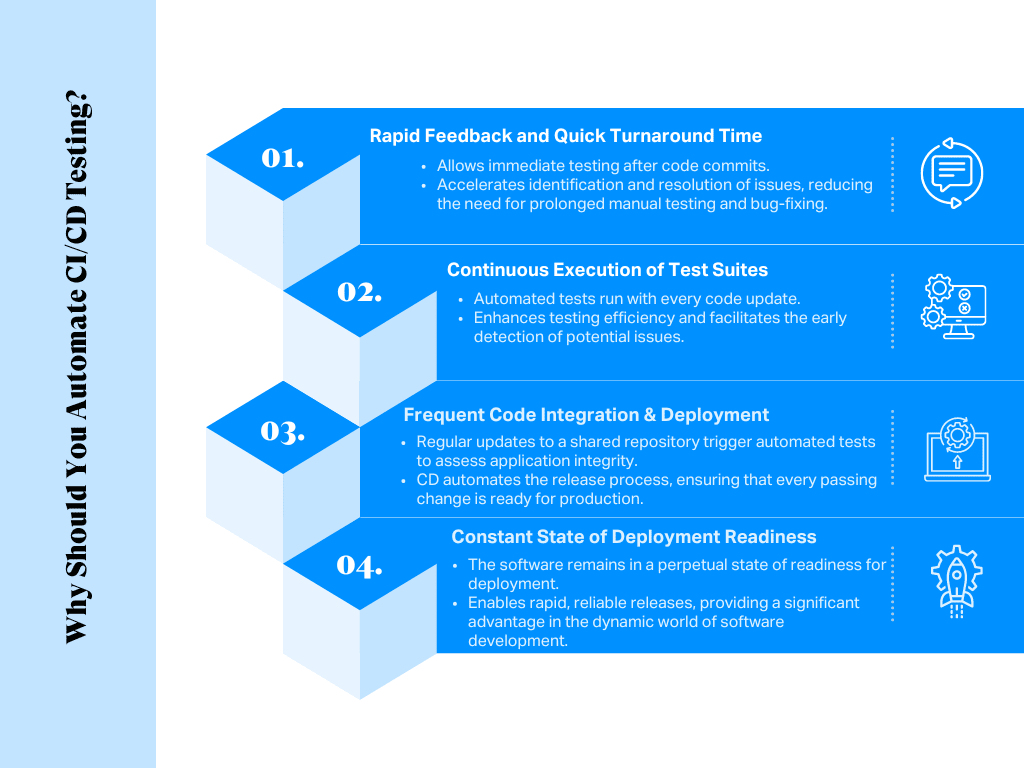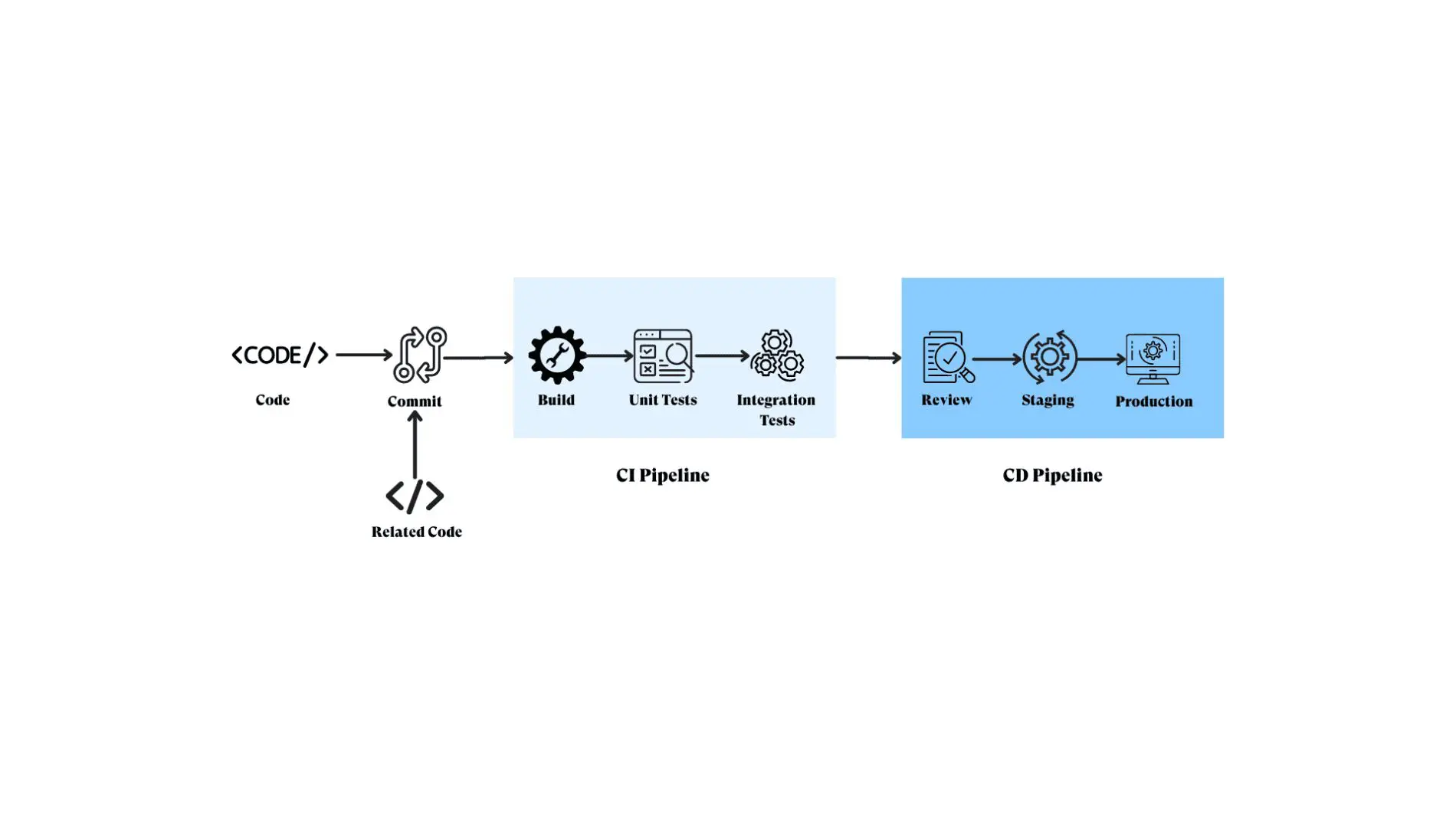Automation For CI/CD

As software development evolves, test automation plays an increasingly significant role in improving efficiency and quality. This is particularly true in the field of Continuous Integration and Continuous Deployment (CI/CD), where CI CD test automation has become a crucial component.
Recent data from the CDF highlights the impact of these practices. Developers using CI/CD tools are consistently outperforming their peers, with at least a 15% higher likelihood of being top performers. Moreover, CI CD test automation implementation can reduce deployment times from months to hours, enabling multiple daily updates.
This article provides an overview of CI CD test automation. We’ll cover the basics, explore why automation is crucial, break down the CI/CD pipeline, and discuss various types of automated tests. You’ll also learn about leading automation tools.
Whether you’re a seasoned DevOps professional or new to the field, prepare to discover how automated testing is redefining the landscape of modern software development.
Table of Contents
- What is CI/CD?
- Automation Testing in CI/CD
- Why Should You Automate CI/CD Testing?
- Automated Testing in the CI/CD Pipeline
- CI/CD Test Automation Tools
- Conclusion
What is CI/CD?
CI/CD stands for Continuous Integration and Continuous Deployment. It’s a set of practices and tools designed to improve the software development process by automating the integration and deployment of code changes.
Continuous Integration (CI) involves developers conducting unit and UI tests before merging their code changes into a shared repository, where automated builds and tests are run. This helps catch bugs early, maintains code quality, and reduces integration issues.
Continuous Deployment (CD) takes this a step further by automatically deploying every change that passes the CI phase to production so that new features and fixes are delivered to users quickly and reliably. Alternatively, Continuous Delivery involves deploying changes to a staging environment for further testing before going live.
Tests must be run as quickly as possible in the CI/CD process to get feedback from the developer as soon as possible. The only way to achieve this is to automate the test suites.
Therefore, automated testing contributes to the CI/CD process by verifying that code changes are thoroughly tested before deployment. This helps maintain high standards of quality and reliability, making the development process more efficient and less prone to errors.
Automation Testing in CI/CD
A CI/CD pipeline is incomplete without automation testing. As a result, CI/CD focuses on “build fast, test fast, fail fast.” CI CD test automation involves executing test scripts automatically and validating results in the Continuous Integration/Continuous Deployment pipeline.
The primary aim of CI CD automated testing is to improve the speed, efficiency, and quality of software delivery. By automating tests, teams can quickly identify and fix bugs, reduce manual effort, and accelerate the overall time to market.
Automation testing is integrated into the pipeline to ensure that developers’ code changes or updates do not break the application’s functionality. This is achieved by automatically triggering a series of tests every time a new code is committed to the source control repository.
If the tests pass, the changes are deployed to the next environment in the pipeline. If any test fails, the pipeline is stopped, and the developers are notified to fix the issue.
Why Should You Automate CI/CD Testing?
CI CD Test Automation plays a crucial role in modern software development. It ensures that code changes are continuously integrated, tested, and delivered, leading to more reliable and effective software releases.
Here are some key reasons why CI CD automated testing is important:

Rapid Feedback and Quick Turnaround Time
One of the most significant advantages of CI CD test automation is the rapid feedback. Instead of the longer testing and bug-fixing phases associated with traditional waterfall development, CI/CD enables immediate testing of code changes following their commit.
This immediate feedback allows developers to address and rectify issues promptly, significantly reducing the time needed for manual testing and bug fixing after development.
Continuous Execution of Test Suites
In a CI/CD environment, test suites are continuously executed. Each code revision triggers a series of tests to verify the application’s integrity. This continuous testing not only improves the testing process, but also enables early detection and resolution of issues.
Frequent Code Integration and Automated Deployment
Continuous Integration (CI) allows developers to frequently update a shared repository with their code changes. As a result of these changes, automated tests are run to determine the integrity of the application.
Continuous Delivery (CD) takes this process further by implementing a deployment automation process. This ensures that tested code changes can be deployed to production at any time, keeping the software up-to-date and ready for release at all times.
Constant State of Deployment Readiness
The CI/CD pipeline ensures that the software is always ready to be deployed. This allows for a fast and reliable release cycle, providing a significant competitive advantage in today’s fast-paced software development landscape.
Why Automated Testing is Beneficial to CI/CD
Automating Continuous Integration and Continuous Deployment (CI/CD) testing brings several advantages to the software development process. Here are some key benefits of automating CI/CD testing:
- Increased Efficiency and Productivity: Automated tests run faster and more frequently than manual tests, allowing developers to focus on writing code rather than testing it.
- Improved Code Quality: Automated pipelines handle repetitive build, test, and deployment tasks, ensuring consistent code quality. This automation reduces the likelihood of human error and allows developers to focus on more complex tasks.
- Faster Feedback and Quicker Problem-Solving: Automated tests provide instant feedback, enabling developers to address issues promptly and reduce the time spent on debugging.
- Enhanced Test Coverage: Automation allows for more comprehensive testing, including edge cases and scenarios that might be overlooked in manual testing.
- Reduced Time to Market: By speeding up the testing process and ensuring continuous integration, automated testing helps in faster delivery of features and updates to the market.
- Consistency Across Environments: Automated tests guarantee that the same tests are run in the same way across different environments, reducing the risk of environment-specific issues.
Automated Testing in the CI/CD Pipeline
The CI/CD pipeline is a transformative approach to software development, allowing for rapid, reliable, and efficient delivery of software changes. Here’s a closer look at how automated testing fits into this pipeline:

- Phase 1: Commit: CI/CD pipelines begin when developers commit their changes to a repository. This could be a new feature, a bug fix, or any other modification to the code. This phase marks the start of the pipeline and sets the stage for the subsequent phases.
- Phase 2: Build: Once the changes are committed, the source code from the repository is integrated into a build. This involves compiling the code and creating an executable version of the application. The build phase ensures that the committed changes do not break the existing code and that the application can be successfully compiled.
- Phase 3: Automated Tests: This is where automated testing comes into play. Once the build is successful, a series of automated tests are run against it. These tests can range from unit tests that check individual application components to integration tests that verify the interaction between different components and functional tests that validate the application’s behavior.
Automated testing is a critical component of the CI/CD pipeline, as it allows for immediate feedback on the impact of the committed changes.
- Phase 4: Deploy: After the automated tests have been successfully passed, the built version of the application is ready to be deployed to production. This phase involves delivering the tested and validated changes to the live environment, where they can be used by end-users.
Different Testing Types in Automation Testing
In a CI/CD pipeline, automated tests play a crucial role in ensuring the quality and reliability of the software.
Here’s how different types of tests fit into the CI/CD pipeline:

- Unit Tests: Unit tests form the foundation of any testing strategy. They are typically written using the Test-Driven Development (TDD) approach and run during the build process. These tests focus on individual code units to ensure they function as expected.
- Integration Tests: Every time a commit is created and deployed to the development environment, integration tests are conducted. New modules and changes are tested to ensure they work well together in these tests. Integration tests may even be carried out in a dedicated environment in some organizations.
- Regression Tests: A regression test is run to ensure that the new changes do not affect the existing code. As a result, it is easier to ensure that the day’s work is up to standard and that any necessary changes have been made.
- Performance and Load Tests: A series of tests are run before releasing code to the production environment to ensure that it is responsive and stable. Testing is conducted on the UAT/Pre-Production environment after the code has been deployed.
- End-to-End Tests: End-to-end tests examine the entire application. While they can be run through the GUI, they don’t have to; an API call can also exercise multiple parts of the system. It is recommended to have fewer of these tests, since they are more fragile and take longer to run.
These testing types are integrated into the CI/CD pipeline to ensure continuous quality and reliability of the software.
CI/CD Test Automation Tools
Several tools facilitate CI/CD testing, each offering unique features and capabilities. Here’s a more detailed look at some of the most popular CI CD test automation tools:
Testsigma
Testsigma is an end-to-end test automation tool designed to test web and mobile applications. It follows a scriptless process, allowing non-programmers to create tests using plain language. With native CI/CD integrations, Testsigma enables smooth test execution within your CI/CD pipeline.
Selenium
Selenium is an open-source framework for automating web applications. The software supports several programming languages, including Java, Python, and C#, which provides flexibility in the development of test scripts. For web testing, Selenium offers a variety of functionalities, including support for various browsers and platforms.
Jenkins
Jenkins provides CI/CD features and automates tests. The platform supports integration with a variety of testing frameworks, including Selenium, JUnit, and TestNG. As part of the CI/CD pipeline, Jenkins can run automated tests and generate detailed test results reports.
Cucumber
Cucumber is a tool that helps you automate your tests and perform behavior-driven development (BDD). Through plain-text executable specifications known as Gherkin, it facilitates collaboration between developers, testers, and business stakeholders. In order to execute automated tests, cucumber can be integrated with CI/CD tools such as Jenkins.
Bitbucket
Bitbucket is a version control system that integrates with CI/CD pipelines. It provides tools to manage source code repositories, collaborate on software development projects, and automate workflows.
Appium
An open-source framework for automating mobile applications, Appium, has been developed exclusively for mobile devices. You can write tests in Java, Python, and Ruby using popular programming languages such as Android and iOS. Mobile app testing can be automated across various devices and platforms with Appium integrated into CI/CD pipelines.
Datadog CI Visibility
Datadog CI Visibility is a performance monitoring tool that provides insights into your CI environment. It helps ensure that your CI/CD pipeline is operating efficiently and that your tests are thorough.
These tools, when used effectively, can significantly enhance the efficiency and effectiveness of your CI/CD pipeline, ensuring that your software is thoroughly tested and ready for deployment. The choice of tool would depend on your specific requirements, the nature of your project, and your team’s preferences.
Conclusion
CI CD test automation stands as an integral part of modern practices that significantly improve the speed, quality, and reliability of software delivery. As CI/CD processes become automated, software updates become more frequent and reliable, while proactive development environments are created for identifying and resolving issues faster.
Investing in trusted QA and test automation providers like Testlio is the best move an organization can make if they want to maximize CI/CD’s potential. Testlio’s comprehensive testing solutions ensure that your deployments are swift, secure, and robust, ready to meet the high standards of today’s tech-driven market.
Dive deeper into how Testlio can revolutionize your CI/CD pipeline by visiting Testlio’s Testing Solutions.
